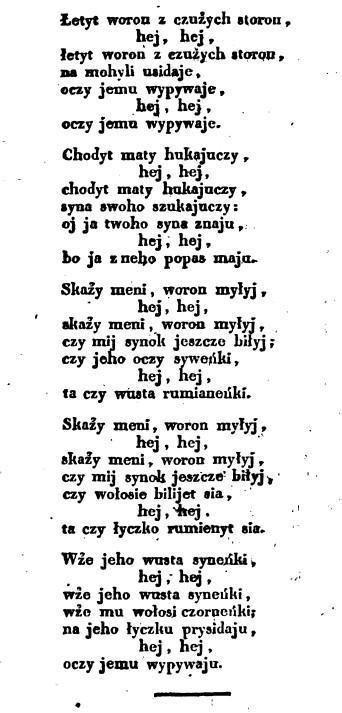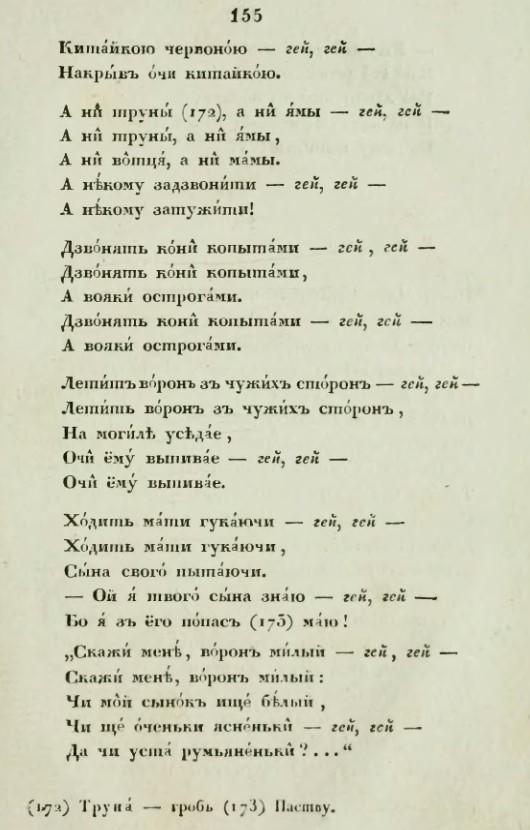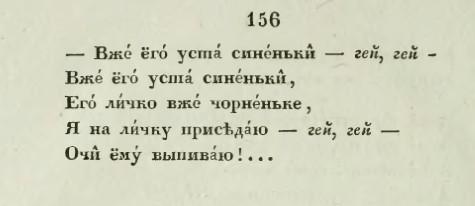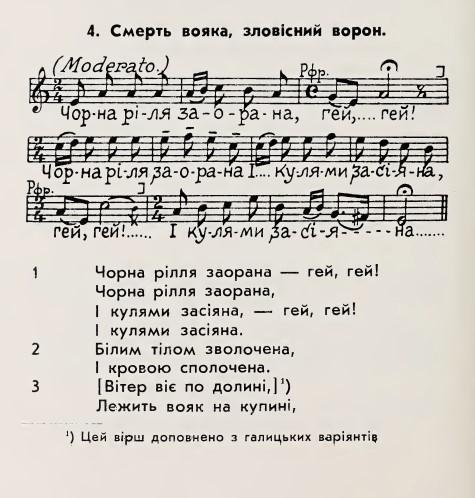Recently, on Instagram I came across an intriguing post from Yiddish Shul, revealing a surprising connection between a famous Yiddish World War I ballad and a Ukrainian folk song. Although I was familiar with the Ukrainian song, its origins were unknown to me. As I delved into its history, I discovered its fascinating history and ties to Galicia.
Origins as a Galician Cossack Ballad
The haunting Ukrainian folk song “Chorna rillia izorana” (Black Field Plowed), which portrays the death of a Cossack on the battlefield, is believed to have originated during the 17th century’s fierce military actions, when fallen Cossacks could be left unburied on the battlefield. The poignant lyrics lament the absence of mourners and burial rites, as a raven feeds off the fallen soldier’s body, while a grieving mother inquires of the raven about her lost son.
Interestingly, the song’s earliest known record was made in Galicia, where a deep connection to ancient Cossack glory thrived, despite Galicia never being Cossack land. This prevalence of Cossack folklore in the region, as highlighted by the 19th-century scholar and ethnographer Yakiv Holovatskyi, can be attributed to the historical trend of young men from here leaving their families to join the Cossacks in the borderlands of Ukraine. He also noted that the epoch of Khmelnytsky witnessed pivotal battles such as Zboriv, Zbarazh, and the siege of Lviv, which further solidified the Cossack spirit in “Red Ruthenia” (a historical name for parts of western Ukraine), fostering a strong cultural bond between Galicia and the heroic Cossack tradition, and inspiring the creation of domestic Cossack songs.
Version by Vasyl Zhdankin with scenes from Cossack movie
First Publications: 1833 in Habsburg Galicia & 1834 in Russian-Ruled Ukraine
The first known publication of “Chorna Rillia” is in the collection Pieśni polskie i ruskie ludu galicyjskiego (Polish and Ruthenian Songs of the Galician Nation) by Polish nobleman, folklore researcher, and political activist Wacław Zaleski (aka Wacław from Olesko), which was published in Lviv in 1833.
The song is found under the section “Wojackie” (military):


A year later, in 1834, Mykhailo Maksymovych, a Ukrainian historian and writer with Cossack heritage in Russian-ruled Ukraine, reprinted the song from Zaleski’s collection in his own anthology called Ukrainian Folk Songs. The song is found in Book III “Cossack Songs” under the “Войсковыя” (military) section. The song is labeled as “Галицкая” (Galician):



English translation of the original song:
Black field plowed, hey, hey!
Black field plowed,
And sown with bullets,
Defiled with a white body, hey, hey!
And bathed in blood.
A soldier lies on the thornbush, hey, hey!
A soldier lies on the thornbush,
His eyes covered with a red kerchief, hey, hey!
His eyes covered with a red kerchief.
No coffin, no grave, hey, hey!
No coffin, no grave,
No father, no mother.
No one to ring the bells, hey, hey!
No one to mourn!
Horses ring the bells with their hooves, hey, hey!
Horses ring the bells with their hooves,
And soldiers with their spurs.
Horses ring the bells, hey, hey!
And soldiers with their spurs.
A raven flies from foreign lands, hey, hey!
A raven flies from foreign lands,
Perches on the grave,
Drinks his eyes, hey, hey!
Drinks his eyes.
A mother walks and calls, hey, hey!
A mother walks and calls,
Asking about her son,
“Oh, I know your son, hey, hey!
For I have lived off him!
“Tell me, dear raven, hey, hey!
Tell me, dear raven, Is my son still fair,
Are his eyes still bright, hey, hey!
Are his lips still rosy?…”
“His lips are now blue, hey, hey!
His lips are now blue,
His face has turned dark,
I sit by his face, hey, hey!
And drink his eyes!…”
On a side note, it’s worth mentioning the importance of these publications, as they marked a new romantic interest in the lives of common folk, impacting Ukrainians in both Galicia and Dnipro Ukraine, respectively. Moreover, by incorporating Galician songs into his collection, Maksymovych bridged the cultural gap between Galician and Russian Ukraine, emphasizing their organic historical unity within the broader Ukrainian ethnocultural space.
Stanislav Liudkevych’s Arrangement & the Song’s Revitalization during the Great War
In the song’s history, another significant moment occurred at the beginning of the 20th century when Ukrainian composer Stanislav Liudkevych arranged it. On June 18, 1910, during a concert of Ukrainian folk songs at the Ruthenian Institute for Girls’ hall in Przemyśl, many of Liudkevych’s choral arrangements were performed for the first time, including “Chorna Rillia Izorana.” We also know that during World War I, in Vienna, at a Shevchenko Evening, Liudkevych’s rendition of the song gained particular fame.
Thus much thanks to Liudkevych’s arrangement, “Chorna Rillia” became the most popular Ukrainian song during the First World War — and it retained its popularity through the Second World War.
In the interwar period, in Warsaw, in 1934, among 50 Ukrainian songs, his arrangement was first recorded on a gramophone record. You can listen to it here:
The text of Liudkevych’s arrangement as heard on the record from 1934:
Чорна рілля ізорана, гей, гей,
Чорна рілля ізорана,
й трупами засіяна, гей, гей
й трупами засіяна.
Білим тілом зволочена, гей, гей,
Білим тілом зволочена,
й кровію сполощена, гей, гей,
й кровію сполощена,
Віє вітер по долині, гей, гей,
Віє вітер по долині,
Лежить жовняр на могилі, гей, гей,
Лежить жовняр на могилі.
Летить ворон з чужих сторон, гей, гей.
Летить ворон усідає.
Йому очі випиває, гей, гей,
Йому очі випиває.
Black field plowed, hey, hey,
Black field plowed,
Sown with corpses, hey, hey,
Sown with corpses.
Defiled with a white body, hey, hey,
Defiled with a white body,
And washed with blood, hey, hey,
And washed with blood.
The wind blows through the valley, hey, hey,
The wind blows through the valley,
The young soldier lies in a grave, hey, hey,
The young soldier lies in a grave.
A raven flies from a distant land, hey, hey,
A raven flies and alights.
It pecks out his eyes, hey, hey,
It pecks out his eyes.
After the First World War, the song appeared in various collections, such as Bohdan Lepkyi’s anthology of Ukrainian poetry Struny, published in Berlin in 1922, as well as in Ukrainian composer Filaret Kolessa’s anthology Ukrainska usna slovesnist (Ukrainian Oral Literature), published in Lviv in 1938, taken from the 1834 collection and using Liudkevych’s melody.


Localized Variations
As time went on, as often happens with folk songs, various adaptations of the song continued to emerge, reflecting local realities, geographical landscapes, and language, and highlighting contemporary events. Despite the variations, many of the main motifs remained – of an unburied soldier, a raven, and a distressed mother.
An abundance of recordings of the song the from various regions in Western Ukraine were made during the 20th century, which clearly showcase how the song underwent various transformations:
“In regional variants, there are local variations: in Zakarpattia, the song ‘Chorna hora neorana’ [The Unplowed Black Mountain] is popular, and in Chernivtsi, ‘Zhurylasia nenka mnoiu’ [My Mother Worrіed About Me] is well-known. The oldest Bukovinian variant was recorded by Yuriy Fedkovych. […] By the way, one of the Pokuttia variants was recorded by Franko in the Kolomyia prison in 1880 (‘Zhurylasia maty mnoiu, scho ne budu ya hazdoyu’) […] In the versions that were recorded later – after the Second World War, noticeable textual changes are observed in the choice of visual imagery. They acquire the characteristics of photographic documentation, achieved through a series of epithets describing the body of the fallen soldier (dead, blackened).” (Oksana Kuzmenko)
Here you can listen to a Zakarpattia version about a “hora” (mountain) instead of “field,” found in a compilation of Ukrainian insurgent songs:
Another Variation
Чорна рілля ізорана, гей-гей.
Чорна рілля ізорана,
І кулями засіяна, гей-гей,
Ще й кулями засіяна…
Білим тілом зволочена, гей-гей.
Білим тілом зволочена,
І кровію сполощена, гей-гей
І кровію сполощена…
Лежить козак на купині, гей-гей.
Ой, лежить козак на купині,
Китайкою личко вкрите, гей-гей,
Китайкою личко вкрите.
А нікому задзвонити, гей-гей.
А нікому задзвонити,
Ще свічечку запалити.
Та нікому затужити..
Black field plowed, hey-hey.
Black field plowed,
And sown with bullets, hey-hey,
Sown with bullets…
Defiled with a white body, hey-hey.
Defiled with a white body,
And bathed in blood, hey-hey,
Bathed in blood…
A Cossack lies on the thornbush, hey-hey.
Oh, a Cossack lies on the thornbush,
His face covered with a kerchief, hey-hey,
His face covered with a kerchief.
No one to ring the bells, hey-hey.
No one to ring the bells,
No one to light a candle.
And no one to mourn…
Adoption by Jewish Culture in the Trenches of the Great War
During World War I, the song of the fallen soldier was embraced by the Jewish community after Jewish soldiers heard Ukrainian troops singing it in the trenches and translated it into Yiddish. From there, it spread widely, becoming one of the most beloved Jewish soldier ballads of the war.
The song — usually called “Dos fertsnte yor” (The Year 1914) or “Of di grine felder” (On the Green Fields) — retained the original melody and many of the same motifs, including the image of a fallen soldier, a black raven, and the absence of mourners and proper funeral rites. However, changes were made to reflect the realities and landscape of the Great War and the experiences of Jewish soldiers, for example, by highlighting the absence of someone to recite the Kaddish. In addition to the alterations from the Ukrainian version, numerous variations of the Yiddish song also emerged, mirroring the diversity of the Ukrainian one.
The song gained such immense popularity across Eastern Europe during and after World War I that it was even amusingly mentioned in a chapter of B. Kuczerer’s Yiddish memoirs of Warsaw titled Geven a mol varshe (Paris, 1955). In this chapter, he recalls the 1914 German occupation of Warsaw and begins by referencing the song:
“The 14th year has arrived – oy vey!
And soon it [the song] enveloped everyone and everything as if by magic… Day and night. Wherever you go, wherever you stand. In every street, in every courtyard, in every corner.
Who sang it loudly to arouse pity. Who sang it quietly, for oneself, to get it off your chest. And everywhere the same song. Everywhere the same melody, the same moan, the same tears.
‘The 14th year has arrived – oy vey!’” (p. 59)
There are also various versions of the song that refer to later years. For instance, in the Sofia Magid collection Unser Rebbe, unser Stalin, Basya Fayler sings about “Dos akhtsnte yor” (“The 18th year,” p. 277-79). Additionally, the linguist Prof. Moshe Taube recalls his father singing this song about “Dos 19te yor,” alluding to the Polish violence against Jews during that period (oral communication) (from “Of di grine felder/Dos fertsnte yor” – Two Performances).
‘Of di grine, felder’
A version referring to a green field and about reciting the Kaddish.
Of di grine, felder velder, vey, vey
Of di grine, felder velder,
ligt mit koyln badekt a zelner, vey, vey,
ligt mit koyln badekt a zelner, vey, vey.
Kim tse flien shvartser foygl, vey, vey
kim tse flien shvartser foygl,
dzhibet oys bay im di oygn, oy vey.
dzhibet oys bay im di oygn, vey, vey.
Sheyner foygl, shvartse vorone vey, vey
Sheyner foygl, shvartse vorona,
fli avek tsi mayn mame, vey vey,
fli avek tsi mayn mame, vey vey.
Zolst ir fin mayn toyt nisht zugn, vey, vey,
zolst ir fin mayn toyt nisht zugn,
anit vet zi nit oyfhern klugn vey, vey.
anit vet zi nit oyfhern klugn vey, vey.
Ver vet nukh mir veynen in klugn vey, vey
ver vet nukh mir veynen in klugn,
ver vet nukh mir kadish zugn? vey, vey.
ver vet nukh mir kadish zugn? vey, vey
Nor dus ferdl, dus getraye, vey, vey
nur dus ferdl dus getraye
vet nukhgeyn nukh mayn levaye, vey, vey.
vet nukhgeyn nukh mayn levaye, vey, vey.
On the green fields, woods, vey, vey!
On the green fields, woods
Lays covered with bullets a soldier, vey, vey
Lays covered with bullets a soldier, vey, vey
Come fly here black bird, vey, vey
Come fly black bird
And peck his eyes out, vey, vey.
And peck his eyes out, vey, vey.
Black bird, black crow, vey, vey
Black bird, black crow
Fly away to my mother, vey, vey.
Fly away to my mother, vey, vey.
Do not tell her of my death, vey vey
Do not tell her of my death
For she will cry and lament, vey, vey
For she will cry and lament, vey, vey.
Who will cry and lament for me? vey, vey
Who will cry and lament for me?
Who will say Kaddish for me? vey, vey.
Who will say Kaddish for me? vey, vey.
Only my faithful horse, vey, vey.
Only my faithful horse
Will follow at my funeral, vey, vey.
Will follow at my funeral, vey, vey.
A version referring to the year 1914 and the Carpathian mountains.
Dos fertsnte yor iz ongekumen, oy vey
Dos fertsnte yor iz ongekumen
In zapas hot men mikh genumen, oy vey
In zapas hot men mikh genumen, oy vey oy vey
In di karpatn zaynen mir gezesn
Broyt mit vaser hobn mir gegesn
Oyf di felder, grine velder
Dortn ligt a gehargeter zelner
Un zayn kerper iz tserisn
Un dos blut tut fun im flisn
Dort ligt a zelner on a tsure
On a kastn un on a kvure
Nit keyn orn, nit keyn mite
Nit keyn foter un nit keyn muter
Kumt a foygl on tsu flien
Oyf zayn keyver optsuruen
Oy, du foygl, shvartse vrone
Na dir di hent un loz op di oygn
…
The year fourteen has come, oy vey
The year fourteen has come,
As a reservist I was called back, oy vey
As a reservist I was called back, oy vey oy vey
In the Carpathians we were stationed
We ate bread and water
On the fields, the green forests
There lies a killed soldier
And his body is teared apart
And the blood is flowing from him
There lies a soldier without a face
Without a coffin, without a burial
No coffin, no casket
No father and no mother
A bird comes flying
To rest on his grave
Oh, you, bird, black crow
Take the hands and leave the eyes
…
A Note On Word Choice and Etymology
Regarding word choice and etymology, it is interesting to note that even the term used to describe the fallen soldier varies across different Ukrainian versions of the song. The original Ukrainian version portrays a fallen “voyak,” meaning “warrior” or “fighter.” In some future versions, this word has been replaced by “kozak” (Cossack) or the Galician dialecticism “zhovniar” (a variant of “zhovnir“), which is similar to the Polish word for soldier, “żołnierz.”
In the Yiddish versions, the fallen soldier is referred to as a זעלנער “zelner,” the Yiddish word for “soldier,” which is linguistically related to the Galician Ukrainian and Polish words. The word is borrowed from Middle High German “soldener,” “soldner,” or “soldenære,” derived from Medieval Latin “soldarius.” In modern German, it is “Söldner.”
The presence of this shared word in Polish, Galician Ukrainian, and Yiddish serves as another fascinating example of cultural diffusion among these three groups, who coexisted in Galicia for centuries.
The Song Today
The song became widely known in Ukraine after its inclusion into the soundtrack to Borys Ivchenko’s film “Propala Hramota” (1972). Subsequently, it continued to undergo changes in various variations. In particular, it was sung by Vasyl Zhdankin, winner of the first Grand Prix of the Chervona Ruta music festival in Chernivtsi (1989). It was also included in the repertoire of Lviv 1970s band Arnika (arranged by Viktor Morozov). Rock bands such as Viy, Polynovoho Polya, and Kolir Nochi have also made well-known versions.
The song has also been picked up by contemporary Jewish groups, such as Psoy & the Israelifts, called “1914” (released 2017), and by Lorin Sklamberg & Susan McKeown, whose version, named “Prayer for the Dead” (released 2009), “weaves together verses from ‘Johnny I Hardly Knew Ye’ with a Yiddish lament for dead soldiers dating from the First World War, and a dirge dating from a millennium ago that is partly in Latin and partly in Irish Gaelic, forming a universal prayer for all who have been lost to war and for a world without such killing and dying.” (Susan McKeown & Lorin Sklamberg — Saints & Tzadiks)
***
In February 2014, during the tragic events of the EuroMaidan in Kyiv, after protesters were shot dead, I recall an evening when I was walking near the Taras Shevchenko monument in the center of Lviv. On the ground, red candle holders were aglow with candles. It was a quiet night, with only a few people present, but I can vividly recollect the sound of the song “Chorna Rillia Izorana” playing, and it brought tears to my eyes.
In the current backdrop of Russia’s full-scale war against Ukraine, many traditional war songs, such as “Chorna Rillia Izorana,” have seen a revival. Here is a version released in April 2023, performed by the singer Lazanovskyi I RIDNYI. He dedicated this rendition to all Ukrainians who lost their lives in the Russo-Ukrainian war.
Listen to More Renditions
Ukrainian versions
English Version
Yiddish Versions
By Areta Kovalska
Sources:
“Dos fertsnte yor,” Yidlid
“Of di grine felder/Dos fertsnte yor” – Two Performances
Станіслав Людкевич: галицька мелодія з вершин і низин
Роман Кирчів, Маніфест української фольклористики*
Shashkevychiyana, Winnipeg, November 1972
Максимович М. Украинские народные песни, Москва, 1834
Оксана Кузьменко ЧОРНА РІЛЛЯ ІЗОРАНА…»: У ФРАНКОВІЙ РЕЦЕПЦІЇ ТА ПІСЕННІЙ ТРАДИЦІЇ СТОЛІТЬ
Wacław Zaleski, Pieśni polskie i ruskie ludu galicyjskiego, Lwów, 1833
Ruth Rubin, Voices of a People: The Story of Yiddish Folksong
Станіслав Людкевич
ДЕНИС ШАТАЛОВ. ПОЧАТКИ «ПОКОЗАЧЕННЯ ГАЛИЧИНИ»: ПУБЛІКАЦІЇ НАРОДНИХ ПІСЕНЬ ТА ПРОМОЦІЯ «КОЗАЦЬКОГО МІФУ» МІСЦЕВИМИ ФОЛЬКЛОРИСТАМИ У 30-40-Х РР. ХІХ СТ. Ч. 1
Перша Світова українською та їдишем
Українська усна словесність
Mike Regenstreif, “Susan McKeown & Lorin Sklamberg — Saints & Tzadiks”






Fascinating history! I wouldnt say though that Ukraine is a borderland. The ethno-linguistic theory of Ukraine as a borderland is imbued with neo-imperialism/neo-colonialism. Obviously to Ukrainians they were never on the borderland to anywhere and in Ukrainian ‘krayina’ means country and ‘okolytsya’ is a borderland. Okolytsya was also the Old East Slavic word for borderland. So really only in Russian, does the borderland theory make sense. And the statement Galicia was ‘never Cossack land’ isn’t 100% accurate. You write yourself that many Ukrainians from Galicia went to the Sich and became Cossacks. Olesko Castle was the residence of Bohdan Khmelnytsky, the Church of the Holy Spirit in Potelych which is on the border with Poland was visited by Khmelnytsky as well. Khmelnytsky and his Cossacks reached Krakow in 1655, in the Treaty of Radnot, Khmelnytsky was allocated almost all of Galicia including Peremyshyl (Przemyśl).
Yes, many Galicians joined the Cossacks, but the land of Galicia was never part of the Sich is what I meant.
As for “borderlands” – I was using the term that Holovatskyi used in his description:
“З давніх-давен жваві молодці, покинувши родину, йшли на пограничну Україну до козаків. Там були соділателями смілих подвигів козацьких проти бусурман. Ціла Южна Русь складалася на таких богатирів, витязів, яких нам історія Укр. так чесно представляє. Але найважніша епоха була за Хмельницького. Тоді наш мир наочним свідком був славних битв під Зборовом, Збаражем, осади Львова. Тоді козацька воля розіллялася, як широкий Дунай, на всю Червенську Русь. Тоді-то зав’язалося стільки любовних союзів із козаками – тогдашні-то майже всі битові козацькі думи[12].”
https://www.historians.in.ua/index.php/en/doslidzhennya/2721-denis-shatalov-pochatki-pokozachennya-galichini-publikatsiji-narodnikh-pisen-ta-promotsiya-kozatskogo-mifu-mistsevimi-folkloristami-u-30-40-kh-rr-khikh-st-chastina-1
[…] Galicia -bloginsa pitämistä. Viime aikoina hän on kirjoittanut muun muassa galitsialaisista kansanlauluista, kansallispuvuista ja kaupunkimuodista sekä pienistä näkyvistä muistoista, kuten nie zamykać […]